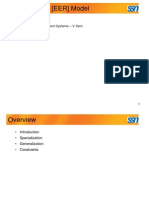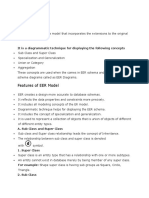0 ratings0% found this document useful (0 votes)
768 viewsAssets Classification
Tangible fixed assets include land and buildings, plant and machinery, and fixtures. IAS 16 outlines the requirements for recognizing property, plant, and equipment as assets when future benefits are probable and costs can be reliably measured. Parts that replace other parts may be recognized if criteria are met. Disclosure requirements include depreciation methods, useful lives, additions and disposals, and commitments to acquire assets. Intangible assets are nonphysical assets controlled through custody or rights that may be initially recognized at cost if definable, probable future benefits, and reliably measurable cost.
Uploaded by
hamarshi2010Copyright
© Attribution Non-Commercial (BY-NC)
Available Formats
Download as PPT, PDF, TXT or read online on Scribd
0 ratings0% found this document useful (0 votes)
768 viewsAssets Classification
Tangible fixed assets include land and buildings, plant and machinery, and fixtures. IAS 16 outlines the requirements for recognizing property, plant, and equipment as assets when future benefits are probable and costs can be reliably measured. Parts that replace other parts may be recognized if criteria are met. Disclosure requirements include depreciation methods, useful lives, additions and disposals, and commitments to acquire assets. Intangible assets are nonphysical assets controlled through custody or rights that may be initially recognized at cost if definable, probable future benefits, and reliably measurable cost.
Uploaded by
hamarshi2010Copyright
© Attribution Non-Commercial (BY-NC)
Available Formats
Download as PPT, PDF, TXT or read online on Scribd
You are on page 1/ 21
Classification of assets
Tangible fixed assets
Tangible fixed assets (TFAs) are defined in
FRS 15 as:
Assets that have physical substance and are Held for
use in the production or supply of goods or services ,
for rental to others , or for administrative purposes on
a continuing basis in the reporting entity activities .
Classification of tangible fixed asset
in the UK the formats for financial reporting
contain three groups for TFAs :
Land and buildings
plant and machinery
fixtures, fittings, tools and equipment
IAS 16 property, plant, and equipment
Recognition
Items of property, plant, and equipment should
be recognised as assets when it is probable
that:
it is probable that the future economic
benefits associated with the asset will flow to
the entity .
the cost of the asset can be measured
reliably .
IAS 16 recognises that parts of some items of
property, plant, and equipment may require
replacement at regular intervals. The carrying
amount of an item of property, plant, and
equipment will include the cost of replacing the part
of such an item when that cost is incurred if the
recognition criteria (future benefits and
measurement reliability) are met. The carrying
amount of those parts that are replaced is
derecognised in accordance with the derecognition
provisions of IAS 16 .
:Example
an aircraft may require regular major inspections
for faults regardless of whether parts of the item
are replaced. When each major inspection is
performed, its cost is recognised in the carrying
amount of the item of property, plant, and
equipment as a replacement if the recognition
criteria are satisfied. If necessary, the estimated
cost of a future similar inspection may be used as
an indication of what the cost of the existing
inspection component was when the item was
acquired or constructed.
Disclosure
For each class of property, plant, and
equipment, disclose :
basis for measuring carrying amount .
depreciation method(s) used .
useful lives or depreciation rates .
gross carrying amount and accumulated
depreciation and impairment losses .
reconciliation of the carrying amount at the
beginning and the end of the period showing:
• additions
• disposals
• acquisitions through business combinations
• revaluation increases or decreases
• impairment losses
• reversals of impairment losses .
• depreciation .
• net foreign exchange differences on translation
• other movements .
restrictions on title .
expenditures to construct property, plant, and
equipment during the period .
contractual commitments to acquire
property, plant, and equipment
compensation from third parties for items of
property, plant, and equipment that were
impaired, lost or given up that is included in
profit or loss .
If property, plant, and equipment is stated at
revalued amounts, certain additional
disclosures are required:
the effective date of the revaluation
whether an independent valuer was
involved .
the methods and significant assumptions
used in estimating fair values
the extent to which fair values were determined
directly by reference to observable prices in an
active market or recent market transactions on
arm's length terms or were estimated using
other valuation techniques .
for each revalued class of property, the carrying
amount that would have been recognised had
the assets been carried under the cost model
the revaluation surplus, including changes
during the period and any restrictions on
the distribution of the balance to
shareholders .
Intangible assets
Intangible assets are defined as :
Non-financial fixed assets that do not have
a physical substance but are identifiable
and are controlled by the entity through
custody or legal rights .
IAS 38 Intangible assets
Under the new standard ias 38 ( applied
from 31 march 2004) an Intangible
asset will be initially recognized at cost
if the following three conditions are
met :
IAS 38 Intangible assets
1. The asset meet the definition of an Intangible
asset- identified and controlled by the
business .
2. its probable that future economic benefits will
flow to the business .
3. the cost of the asset can be measured
reliably .
Intangible assets and initial carrying value
In determining the value at initial recognition
we need to consider three cases :
1. an intangible asset purchased separately
this asset should be capitalised at its cost .
2. an internally developed intangible fixes
asset may be captialised only if it has a
readily ascertainable market value
In this case the entity has the choice whether
to capitalised the asset or not .
3. Intangible fixed asset acquired as part of
purchase of a business .
Intangible asset should be capitalised
separately from goodwill, if its value can
measured reliably on initial recognition .
In this case the intangible asset should initially
recorded at its fear value .
Note:unless the asset has readly ascertainable
market value , the fear value should be
limited to an amount that doesnt create
negative goodwill arising on acquisition .
You might also like
- 19-ARID-490 - Warda Abbas (HCI Final Exam Theory)No ratings yet19-ARID-490 - Warda Abbas (HCI Final Exam Theory)5 pages
- Intruders: Tran Song Dat Phuc Department of Computer Science and Engineering Seoultech 2014No ratings yetIntruders: Tran Song Dat Phuc Department of Computer Science and Engineering Seoultech 201465 pages
- Functions and Characteristics of ComputerNo ratings yetFunctions and Characteristics of Computer15 pages
- Amazing C++ If, Else & Switch StatementsNo ratings yetAmazing C++ If, Else & Switch Statements25 pages
- INFORMATION-PRIVACY.pptx-Alther-MahinayNo ratings yetINFORMATION-PRIVACY.pptx-Alther-Mahinay33 pages
- Intro-InformationAssurance-Security - Part1No ratings yetIntro-InformationAssurance-Security - Part121 pages
- Application of Computer in Various Fields 2No ratings yetApplication of Computer in Various Fields 245 pages
- Transaction Concepts: Service-Oriented ComputingNo ratings yetTransaction Concepts: Service-Oriented Computing38 pages
- PPT01 - Introduction To Interface DesignNo ratings yetPPT01 - Introduction To Interface Design27 pages
- Do You Know What Is Virtual Reality? or Had You Even Heard It ?No ratings yetDo You Know What Is Virtual Reality? or Had You Even Heard It ?12 pages
- 12K502 Programmable Logic Controller: Microcontrollers andNo ratings yet12K502 Programmable Logic Controller: Microcontrollers and6 pages
- Lecture 1 Networking Fundamentals RevisedNo ratings yetLecture 1 Networking Fundamentals Revised34 pages
- Disk Storage, File Structure and HashingNo ratings yetDisk Storage, File Structure and Hashing30 pages
- 07slide (Math Functions Characters and Strings)No ratings yet07slide (Math Functions Characters and Strings)42 pages
- Front-End Developer Portfolio by SlidesgoNo ratings yetFront-End Developer Portfolio by Slidesgo46 pages
- Chapter 6. - OS Database Security) OL - Edited2No ratings yetChapter 6. - OS Database Security) OL - Edited249 pages
- Cable Configuration: Instructor, Local Tip-Manila Coe Cisco Networking Academy Program100% (1)Cable Configuration: Instructor, Local Tip-Manila Coe Cisco Networking Academy Program23 pages
- Chapter 4 - Operating System and SecurityNo ratings yetChapter 4 - Operating System and Security18 pages
- The Need For International Accounting StandardNo ratings yetThe Need For International Accounting Standard8 pages
- Harmonization of International Accounting Standards100% (1)Harmonization of International Accounting Standards9 pages
- Research Methodology and Theories On The Uses of Accounting Information83% (6)Research Methodology and Theories On The Uses of Accounting Information19 pages
- Chapter 5 Assets 1 Reporting Losses and Gains On Revaluation100% (1)Chapter 5 Assets 1 Reporting Losses and Gains On Revaluation16 pages
- Carpentier Charlotte Master Thesis How To Value Brands CorrectlyNo ratings yetCarpentier Charlotte Master Thesis How To Value Brands Correctly88 pages
- Ch-1 - BC-BF - Structure of Indian Banking - PPTsNo ratings yetCh-1 - BC-BF - Structure of Indian Banking - PPTs45 pages
- Chapter 2 (Prob.1-10) - Partnership and Corp.No ratings yetChapter 2 (Prob.1-10) - Partnership and Corp.10 pages
- Andrea Vda de Aguinaldo v. CIR (13 SCRA 269)No ratings yetAndrea Vda de Aguinaldo v. CIR (13 SCRA 269)2 pages
- Making Strategic Alliances and Networks Work: Global Strategy Global StrategyNo ratings yetMaking Strategic Alliances and Networks Work: Global Strategy Global Strategy16 pages
- BLMGNF Thousand Currents Asset Transfer AgreementNo ratings yetBLMGNF Thousand Currents Asset Transfer Agreement58 pages
- 603unit 6 Insurance Regulation and SupervisionNo ratings yet603unit 6 Insurance Regulation and Supervision38 pages
- Problems of Rural Marketing - Their SolutionNo ratings yetProblems of Rural Marketing - Their Solution20 pages
- Adani Wilmar Limited: Please Read Section 32 of The Companies Act, 2013No ratings yetAdani Wilmar Limited: Please Read Section 32 of The Companies Act, 2013398 pages
- Chapter 20 Incomplete Record Q16 Pg.201 WB2No ratings yetChapter 20 Incomplete Record Q16 Pg.201 WB24 pages
- Intruders: Tran Song Dat Phuc Department of Computer Science and Engineering Seoultech 2014Intruders: Tran Song Dat Phuc Department of Computer Science and Engineering Seoultech 2014
- Do You Know What Is Virtual Reality? or Had You Even Heard It ?Do You Know What Is Virtual Reality? or Had You Even Heard It ?
- 12K502 Programmable Logic Controller: Microcontrollers and12K502 Programmable Logic Controller: Microcontrollers and
- Cable Configuration: Instructor, Local Tip-Manila Coe Cisco Networking Academy ProgramCable Configuration: Instructor, Local Tip-Manila Coe Cisco Networking Academy Program
- Harmonization of International Accounting StandardsHarmonization of International Accounting Standards
- Research Methodology and Theories On The Uses of Accounting InformationResearch Methodology and Theories On The Uses of Accounting Information
- Chapter 5 Assets 1 Reporting Losses and Gains On RevaluationChapter 5 Assets 1 Reporting Losses and Gains On Revaluation
- Carpentier Charlotte Master Thesis How To Value Brands CorrectlyCarpentier Charlotte Master Thesis How To Value Brands Correctly
- Making Strategic Alliances and Networks Work: Global Strategy Global StrategyMaking Strategic Alliances and Networks Work: Global Strategy Global Strategy
- Adani Wilmar Limited: Please Read Section 32 of The Companies Act, 2013Adani Wilmar Limited: Please Read Section 32 of The Companies Act, 2013
































































































